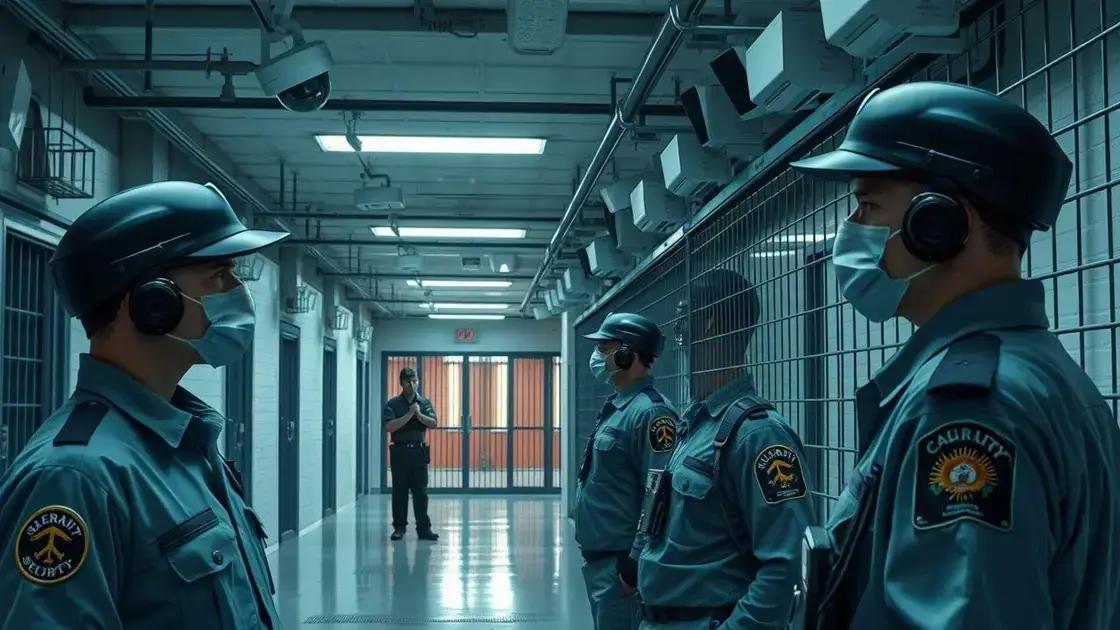A look inside El Salvador’s high-security CECOT prison

Anúncios
A look inside El Salvador’s high-security CECOT prison reveals a facility focused on severe security measures, inmate rehabilitation challenges, and the impacts on local crime rates.
A look inside El Salvador’s high-security CECOT prison sheds light on the complex realities faced by inmates. Have you ever wondered how life is structured behind those high walls? Let’s dive deeper into this unique environment.
Anúncios
Understanding the history of CECOT prison
The story of CECOT prison is complex. Established to handle high-risk inmates, the prison serves a critical role in El Salvador’s criminal justice system. From its inception, CECOT has been a key facility in managing violent offenders and attempting to rehabilitate them.
Historical Background
CECOT, or the Centro de Confinamiento del Terrorismo, opened its doors in 2016 amidst escalating violence and gang activity in the country. The need for a prison specifically designed to house the most dangerous criminals led to its creation. The government aimed to provide a safer environment for inmates and staff while generating a more controlled space.
Anúncios
Key Events in CECOT’s History
- 2016: CECOT officially opens, marking a new strategy in prison management.
- 2017: The first wave of notorious gang leaders is transferred to CECOT.
- 2020: Enhanced security measures implemented due to violent incidents.
- 2022: Rise in inmate population impacts daily operations.
Over the years, CECOT has seen significant changes. Initially designed to hold a specific capacity, it now struggles with overcrowding. The prison’s design focuses on minimizing violence among inmates and offers resources for rehabilitation. However, some challenges remain, including maintaining order and preventing escapes.
Moreover, the prison’s reputation has grown internationally, with human rights organizations keenly observing its practices. Discussions surrounding the treatment of inmates also gain attention, raising questions about the balance between security and humane treatment. As we understand the history of CECOT, it becomes clear that its operations reflect larger societal issues related to crime and punishment.
Life inside the high-security facilities
Living conditions inside the high-security facilities of CECOT prison are challenging and often harsh. Inmates face strict routines designed to maintain order and security. Each day is structured from morning until night, emphasizing discipline and control.
Daily Life of Inmates
Inmates usually wake up early to the sound of alarms. After morning roll call, they engage in assigned activities, which may include labor or educational programs. Meals are typically served in a communal setting, limiting interaction with others outside designated groups. These daily activities aim to provide a sense of normalcy amidst confinement.
Security Measures
- High walls and fences ensure no escape is possible.
- Guards conduct regular patrols to monitor behavior.
- CCTV cameras are installed throughout the facility for constant surveillance.
- Strict visitor policies reduce the risk of contraband entering the prison.
Despite intended benefits, life in such an environment can lead to tension and conflict. Inmates often form groups for protection, which can lead to gang activity within the prison. The management of these interactions is vital to prevent violence and maintain order.
Rehabilitation programs play a crucial role in the lives of inmates. Many focus on skill development and psychological support, aiming to prepare individuals for reintegration into society. However, the effectiveness of these programs can vary widely, depending on resource availability and inmate participation.
Food and living conditions significantly impact inmate morale. While the prison provides basic necessities, many inmates express dissatisfaction with the quality of food and overcrowding. Such conditions contribute to broader issues of mental health and well-being within the facility.
Security measures and protocols

Security measures and protocols in CECOT prison are essential for maintaining order and safety. These strict protocols are in place to prevent violence and manage the risks associated with housing high-risk inmates. The focus on security reflects the serious nature of the crimes committed by those incarcerated here.
Layered Security Systems
One of the key elements of security at CECOT is the layered approach. High walls and fences are only the beginning. Guards patrol the perimeter constantly, ensuring that no unauthorized personnel enter the premises.
Surveillance Technology
Advanced surveillance technology is crucial for monitoring inmate behavior. CCTV cameras cover nearly every inch of the facility, providing live feeds to the command center. This constant monitoring allows for quick responses to any disturbances.
- Daily checks of all equipment ensure functionality.
- Strict procedures for inmate movement reduce risks of escape.
- Emergency protocols are practiced regularly with all staff members.
In addition to physical security, psychological safety is equally important. Guards are trained to recognize signs of unrest and potential conflicts between inmates. By intervening early, they can prevent violence before it escalates.
Cohesion among the staff is a vital part of the security strategy. Regular training sessions help maintain standards and ensure that all personnel are aware of best practices. Inmates are also educated about the rules to minimize misunderstandings and promote constructive behavior.
Certain areas of the prison are designated as high-security zones where only select staff members are allowed. These zones house the most dangerous inmates and have enhanced security protocols to prevent any incidents.
Profiles of notable inmates
Within the walls of CECOT prison, several notable inmates have drawn attention for their criminal activities and backgrounds. These individuals often have complex stories, reflecting broader societal issues. Their profiles illustrate the challenges faced by the justice system in addressing crime in El Salvador.
High-Profile Criminals
Some inmates have gained notoriety due to their roles in major gang operations. For instance, leaders of notorious gangs have found themselves incarcerated at CECOT. These high-profile individuals wield significant influence, even behind bars, making their management a top priority for prison authorities.
Individual Stories
- José: A well-known gang leader, José was arrested for orchestrating numerous violent crimes. His story highlights the cycle of violence perpetuated by gang culture.
- Maria: Convicted of drug trafficking, Maria’s case sheds light on the role of women in organized crime. Her background reveals the impact of socioeconomic factors on criminal behavior.
- Diego: Once a prominent figure in his community, Diego fell into crime as a means to escape poverty. His journey illustrates the struggles many face.
The experiences of these inmates are often intertwined with systemic issues in El Salvador. The society they come from can significantly shape their choices and futures. As their stories unfold, many advocate for understanding and rehabilitation rather than merely punishment.
Inmate interviews highlight their reflections on life before and after imprisonment. They express feelings of regret and a desire for change. These insights provide a glimpse into the mindset of those who occupy CECOT, inviting dialogue about crime, punishment, and rehabilitation.
The profiles of notable inmates also pose challenges for prison staff. Maintaining order becomes complex when dealing with influential or charismatic individuals. Policies are often put in place to manage interactions between inmates, especially those with significant followings.
The impact on crime and rehabilitation
The impact of CECOT prison on crime and rehabilitation is significant in El Salvador. As a facility designed for high-risk offenders, it often reflects broader societal challenges. Some believe that the existence of CECOT helps reduce crime rates by removing the most dangerous individuals from society.
Effects on Crime Rates
When high-profile gang leaders and violent offenders are incarcerated at CECOT, statistics show a temporary decline in gang activities outside of prison. Law enforcement observes a correlation between high incarceration rates and the reduction of violent crime in some areas.
Challenges in Rehabilitation
Despite these benefits, rehabilitation within CECOT presents unique challenges. Many inmates arrive with complex backgrounds rooted in poverty and violence. The prison offers programs aimed at education and mental health, but participation can be inconsistent due to various factors.
- Access to education can be limited based on security measures.
- Psychological support is often inadequate to address deeper issues.
- Inmates may resist programs if they feel no connection to their future.
The environment within CECOT can also hinder effective rehabilitation. Overcrowding and tension among inmates create a difficult atmosphere for personal growth. Inmates often find it challenging to focus on rehabilitation when faced with daily conflicts.
However, success stories do exist. Some individuals who participate in educational programs and therapy show signs of positive change. These stories highlight the potential for transformation, even within a high-security setting. The ability of inmates to gain skills or receive counseling can play a crucial role in their reintegration into society after release.
Overall, while CECOT plays a role in addressing crime, it also faces considerable hurdles in promoting successful rehabilitation. The balance between security and the potential for change remains a vital discussion in El Salvador’s approach to criminal justice.
FAQ – Frequently Asked Questions about Life in El Salvador’s CECOT Prison
What measures are in place to ensure security within CECOT prison?
CECOT employs high walls, frequent guard patrols, and extensive CCTV surveillance to maintain security and monitor inmate behavior.
How does CECOT impact crime rates in El Salvador?
The incarceration of high-risk offenders at CECOT has been associated with a temporary decline in gang activities and violent crime in surrounding areas.
What rehabilitation programs are available to inmates at CECOT?
CECOT offers educational and psychological programs aimed at helping inmates develop skills and address mental health issues.
What challenges do inmates face in rehabilitation at CECOT?
Inmates contend with overcrowding, limited resources, and high tension, which can hinder their ability to participate effectively in rehabilitation programs.






